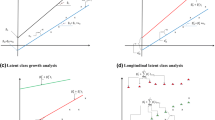Summary
New Bayesian cohort models designed to resolve the identification problem in cohort analysis are proposed in this paper. At first, the basic cohort model which represents the statistical structure of time-series social survey data in terms of age, period and cohort effects is explained. The logit cohort model for qualitative data from a binomial distribution and the normal-type cohort model for quantitative data from a normal distribution are considered as two special cases of the basic model. In order to overcome the identification problem in cohort analysis, a Bayesian approach is adopted, based on the assumption that the effect parameters change gradually. A Bayesian information criterion ABIC is introduced for the selection of the optimal model. This approach is so flexible that both the logit and the normal-type cohort models can be made applicable, not only to standard cohort tables but also to general cohort tables in which the range of age group is not equal to the interval between periods. The practical utility of the proposed models is demonstrated by analysing two data sets from the literature on cohort analysis.
Similar content being viewed by others
References
Akaike, H. (1980). Likelihood and the Bayes procedure,Bayesian Statistics (eds. J. M. Bernardo, M. H. DeGroot, D. V. Lindley and A. F. M. Smith), Valencia, University Press.
Bradley, E. L. (1973). The equivalence of maximum likelihood and weighted least squares estimates in the exponential family,J. Amer. Statist. Ass.,68, 199–200.
Fienberg, S. E. and Mason, W. M. (1978). Identification and estimation of age-period-cohort models in the analysis of discrete archival data,Sociological Methodology 1979 (ed. K. F. Schuessler), London, Jossey-Bass.
Glenn, N. D. (1977).Cohort Analysis, Biverly Hills and London, Sage Publications.
Ishiguro, M. and Akaike, H. (1981). A Bayesian approach to the trading-day adjustment of monthly data,Time Series Analysis, (eds. O. D. Anderson and M. R. Perryman), Amsterdam, North-Holland.
Ishiguro, M. and Sakamoto, Y. (1984). A Bayesian approach to the probability density estimation,Ann. Inst. Statist. Math., B,36, 523–538.
Kashiwagi, N. (1982). A Bayes estimation procedure for fertilities in field experiments,Res. Memo., No. 220, Tokyo, the Institute of Statistical Mathematics.
Knoke, D. and Burke, P. J. (1980).Log-Linear Models, Biverly Hills and London, Sage Publications.
Mason, W. M. and Fienberg, S. E. (eds.) (1985).Cohort Analysis in Social Research, New York, Springer-Verlag.
Mason, K. O., Mason, W. M., Winsborough, H. H. and Poole, W. K. (1973). Some methodological issues in cohort analysis of archival data,American Sociological Review,38, 242–258.
Nakamura, T. (1982). A Bayesian cohort model for standard cohort table analysis,Proc. Inst. Statist. Math.,29, 77–97. (In Japanese)
Pullum, T. W. (1978). Parameterizing age, period, and cohort effects: an application to U.S. delinquency rates, 1964–1973,Sociological Methodology 1978 (ed. K. F. Schuessler), San Francisco, Jossey-Bass.
Ryder, N. B. (1965). The cohort as a concept in the study of social change,American Sociological Review,30, 843–861.
Smith, M. D. (1979). Increasing in youth violence: age, period or cohort effect, Presented at the Meetings of the American Sociological Association, Boston (Cited by Knoke and Burke (1980)).
Additional information
The Institute of Statistical Mathematics
About this article
Cite this article
Nakamura, T. Bayesian cohort models for general cohort table analyses. Ann Inst Stat Math 38, 353–370 (1986). https://doi.org/10.1007/BF02482523
Received:
Revised:
Published:
Issue Date:
DOI: https://doi.org/10.1007/BF02482523




